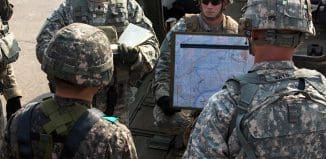The Rise of the Shi’ite Militias and the Post-Arab Spring Sectarian Threat
This post is also available in:  עברית (Hebrew)
עברית (Hebrew)
By Ms. K. Gilbert, Research Assistant, ICT

The development and increasing strength of politicized religiosity among Shi’ites should be viewed as the result of several important socio-political trends taking place in the contemporary Arab World, chiefly among them the rise of sectarian identity in the wake of the failure of ideologies such a communism, secularism and pan-Arab nationalism. The Arab Spring has ushered in a new era of turmoil, violence and political instability in the Middle East, and the overthrow of secular-nationalist dictatorial regimes, such as that of Gaddafi in Libya and Mubarak in Egypt, has resulted in the ultimate weakening of notions of territorial sovereignty in much of the Arab World, and with it nationalist identities. A dangerous unintended consequence of the revolutions and protest movements which erupted following the fall of Tunisia’s Ben Ali in December 2010 has been the rise of sectarianism as the prime political driver in the region. This trend has been particularly striking among the historically downtrodden Shi’ite communities of the Arab World. Disillusioned by notions of nationalism which only further entrenched the status quo of Shi’ites as second-class participants in the national projects of countries such as Iraq, Lebanon and Bahrain, the Arab Spring has driven Shi’ite communities to “fashion organizational-political mechanisms that manipulate primordial solidarities as a means for social and political change.”
An important component in the development of Shi’ite political-sectarian identity has been the centrality of the theme of persecution and marginalization in Shi’ite religious doctrine and practice, embodied by the martyrdom of Husayn at Karbala in 680CE and re-lived by Shi’ites through the annual ‘Ashura rituals. The martyrdom of Husayn, depicted as a brave soldier who sacrificed his life for Islam in the struggle against tyranny, functions as a metaphor for the Shi’ite community’s identity as a persecuted minority within the Sunni-Arab World, with the ‘Ashura rituals assuming a centrality and relevance not only to contemporary Shi’ite religiosity but also in the social and political spheres. Indeed, the development of Shi’ite theology and religious doctrine should be considered in the context of their historical marginalization as a minority community. At times harshly persecuted as heretics by Sunni Muslim rulers, and denied political expression or civil empowerment, the Shi’ite community abandoned temporal political goals in the time of the Sixth Imam Ja’far al-Sadiq, and increasingly came to view itself from the perspective of a ‘minority vs. majority’ dichotomy. Despite two notable cases of Shi’ite political expression in the Middle Ages, being the Fatimid and Safavid Empires of North Africa and Greater Persia respectively, it was not until modern times that Shi’ism emerged as a political driving force in the Middle East, a development which ultimately pushed the Muslim sectarian split from the religious to the political sphere.
IHLS – Israel Homeland Security
The Iranian Revolution of 1979 is of course the event which propelled Shi’ism into the realm of an all-encompassing political ideology- radically reworking Twelver Shi’ite theology in the process; building on the theological justifications for clerical rule established in Iran centuries earlier by the Safavid Shahs. Iran, long a majority-Shi’ite state, became both an example and a patron to Shi’ite communities in the Arab world still denied a political voice by ostensibly nationalist Sunni governments and regimes. Despite the Ayatollahs’ stated policy of ‘Exporting the Revolution,’ it was not until the uprisings of the Arab Spring some thirty years later that Shi’ite communities began to rally in large numbers for greater political power and rights. What began as a regional protest movement often uniting both Sunni and Shi’a against oppressive governance, economic failings and large-scale violations of civil rights has developed into bitter sectarian divisions, amplified by the ‘Cold War’ between Saudi Arabia and Iran and ‘divide and rule’ tactics employed by embattled rulers seeking to cling to power in states such as Syria, Yemen and Bahrain.
Click here for the full report.






























